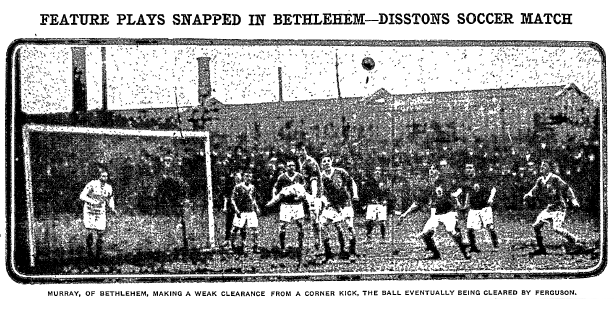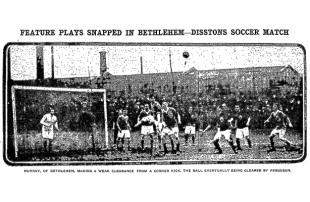Photo: From the Philadelphia Inquirer, December 26, 1915
The annual tradition of Christmas Day soccer games in Philadelphia — which began as early as 1889, the inaugural season of the city’s first organized league, the Pennsylvania Football Union — continued one hundred years ago in 1915.
There was much to celebrate in the area soccer scene. The city was home to the most vibrant collection of league’s in the country, with the Philadelphia Inquirer reporting on December 26, 1915, “Philadelphia, as usual, was to the fore in the number of teams playing the game, it being estimated that at the present time there are more leagues in this city than in any other three cities in the United States.” The 1916-17 Spalding Guide reported that, during the 1915-16 season, the Football Association of Eastern Pennsylvania and District, the United States Football Association-affiliated regional governing body, had 142 member clubs in nine member leagues. The Allied American Football Association alone contained five divisions comprised of forty-five clubs and nine associated clubs. Some three thousand local players were registered with the Eastern Pa. and District, 97 percent of whom were registered as amateurs. The importance of youth development was recognized. The Grammar School League consisted of 24 clubs across four divisions.
Bethlehem Steel, who played in the city’s American League, which the Inquirer reported was “considered the strongest professional league in the country,” were the champions of the National Challenge Cup, known today as the US Open Cup. Haverford had just defeated reigning champions University of Pennsylvania to claim the Intercollegiate League title. And on December 19, the launch of a new Philadelphia league was announced, the Industrial League, which would be made up of teams backed by the area’s leading manufacturing establishments.
Eight games would be played in Philadelphia on Christmas Day, 1915. Among the more notable contests would be an exhibition game at Third Street and Lehigh Avenue between picked teams of Philadelphia’s Allied League and New York’s Metropolitan League. But the most important games of the day were two National Challenge Cup playoff games, with Disston hosting Bethlehem at Disston Ball Park at State Road and Unruh Street, and Hibernians hosting Viscose at Stenton Field at 24th and Westmoreland Streets.
Philly All-Stars draw with New York
The pick of Philadelphia’s Allied League took a 1-0 lead in the first half against their opponents from New York’s Metropolitan League thanks to goal from center forward Ihrig, the Inquirer reporting on December 26 that Ihrig obtained “possession of the ball near midfield and [dribbled] it down to the goal mouth.”
The Allied Leaguers continued to dominate play early in the second half at Fairhill Ball Park “but the many shots that were directed at the visitors’ new went wide.” Midway through the second half, the New Yorkers scored an equalizer and the game finished as a 1-1 draw.
Another picked team from the Allied League traveled to Bethlehem on Christmas Day to face the pick of the Blue Mountain League. The Philadelphia team arrived two players short and, after the final whistle the other nine players probably wished they too had stayed home.
Playing on what the Inquirer described on December 26 as “a field of water and mud,” the Allied Leaguers, their numbers filled out by the loan of two Blue Mountain League players, were resoundingly defeated, 7-0.
Hibs and Viscose draw again in National Challenge Cup play
Before their second round 2-2 draw on December 11, Hibernians, who played in the city’s professional American League, had crushed Allied American first division side Peabody 15-0 in the first round of play, while Marcus Hook’s Viscose team had edged Allied American first division rivals Putnam, 2-1. The teams were not originally scheduled to meet on Christmas Day to resolve the second round draw but bad weather meant the replay scheduled for December 18 had to be postponed.
As it turned out, the Christmas Day meeting was a back and forth affair. Viscose inside left J. Doherty opened the scoring in the first half, with Hibs center forward Gallagher equalizing soon after. Dougherty then tallied again only for inside right Barrett to score for Hibernian to level the scoreline. Viscose outside right A. Doherty tallied before the half to give the visitors a 3-2 lead.
After the start of the second half, it was the turn of inside left Robinson to level the score, which stood at 3-3 after the expiration of regular time. Two extra time periods of 15 minutes were played but neither team was able to find the back of the net.
The teams would meet again on New Year’s Day.
Bethlehem downs Disston to advance to third round of National Challenge Cup

From the Philadelphia Inquirer, December 26, 1915
The path of American League rivals Bethlehem and Disston to the second round of the National Challenge Cup had been an easy one, with Bethlehem defeating Blue Mountain League side Bethlehem East Ends 9-0 in the first round, and Disston topping Allied first division side Wanderers, 3-0. The two teams drew 1-1 after extra time in their first second round meeting on December 11 and, as had been the case with Hibernian-Viscose, their scheduled replay on December 18 was postponed due to bad weather.
When the teams met on Christmas Day, Bethlehem opened the scoring ten minutes into the first half following a breakaway down the right wing, the Inquirer reporting, “Butler and MacDonald taking the ball nearly half the length of the field before the almost hairless Pepper scored with a splendid shot.” The visitors scored a second goal soon after, one that was “the result of of a well-finished movement which came from ‘Whitey’ Fleming, who crossed the ball right into the goal mouth for Butler to have his name engraved on the scoresheet.” In the second half, Bethlehem made it 3-0, although the Inquirer reported the goal “should never been allowed, for Brown, before receiving the ball from Pearce, was in an off-side position.”
The Inquirer described the game as “one of the poorest played games of the season,” adding, “Although the steel workers won by such a big margin there was not that much difference in the run of the game for Disstons had just as much of the play as their opponents, but failed to make the most of their opportunities, while on the other hand, Bethlehem produced the more finished soccer and also had the punch at the psychological moment, which accounted for them winning by such a large score.” Regardless, Bethlehem advanced to the third round where they would meet the winner of the Hibernian-Viscose second round pairing.


Comments